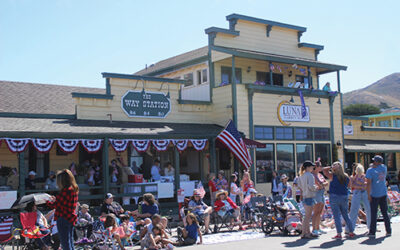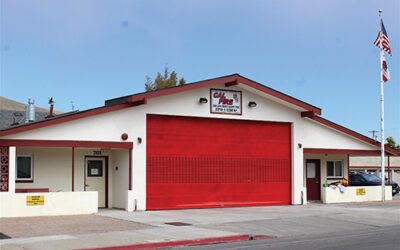Continuing its program to address seawater intrusion and shore up its water system, the Los Osos Community Services District wants to drill a new drinking water well under an old community leach field.
According to a staff report by CSD General Manager, Ron Munds, the CSD has been trying to site a new water well in the town’s “lower” aquifer for several years, and in 2018 took a stab at drilling a well adjacent to Los Osos Middle School, one of four sites that were being considered.
The test well work, Munds said, was completed in January 2020, “with disappointing results. It was determined that the geology of the area is not suitable for a community water supply well site.”
That left the agency to contemplate other sites, which is being done under a settlement agreement the CSD entered into with the town’s other water purveyors — Golden State Water Co., S&T Mutual, and SLO County — that is supposed to address extensive seawater intrusion that has stretched inland nearly to the Los Osos Library along the Los Osos Valley Road corridor.
The seawater intrusion is one of the nagging problems the town faces with its water supply, which comes entirely from a groundwater basin that is split into a “lower” and “upper” aquifer, separated by an impenetrable clay layer.
For decades, before the completion of a community sewer system in April 2016, the town was on septic systems that took water pumped from the lower aquifer deep below ground, run through homes and businesses, treated and disposed of via septic tanks and leach fields, into the upper aquifer.
And that groundwater is supposedly high in nitrates, which was the basis for the State’s orders to retrofit a collections system and sewage treatment plant throughout most of the community.
And because the town relies entirely on groundwater, the County back in the mid-1990s declared a “Severity Level III” on the basin due to over drafting — which means the town takes more water out of the aquifer than rainfall can replenish.
So as a result of a lawsuit brought by the CSD, the water companies agreed to address the seawater/over drafting issues under a Basin Plan. Among the solutions is a phased approach to moving well production easterly, away from the seawater intrusion zone. Also, the plans are to tap that upper aquifer where the septage had been discharged for all those years.
Five sites were studied in an “Environmental Constraints Analysis” by the CSD’s consultants, Cleath-Harris Geologists, and two of them passed muster.
The sites studied included two sites on Sage Avenue, one of which already has an agricultural well; Andre Avenue; a former community septic system site that served the Bayridge Estates neighborhood; and a site on Ramona Avenue in a County right of way.
After the constraints analysis, the Bayridge and Andre sites rose to the top.
The district board in November decided to go ahead at the Bayridge Estates site, which is already owned by the CSD. The anticipated yield from a new well there is 80-acre feet a year, but the yield from the Andre Avenue site is 140 AFY.
Munds told Estero Bay News that the chosen site is bordered by an office complex at the southern end of South Bay Boulevard, the Sage Eco-Landscaping Company headquarters, and nearby homes.
Asked if he has concerns about contaminates in the ground water underneath an old leach field, Munds said the upper aquifer is 150-200 feet deep at the site and the new well will be drilled down to 650-700 feet.
“We’re going well below the upper aquifer,” Munds said. “There aren’t any water quality issues; the field has been inactive for about four years now.” In the end, Bayridge had the easier path to fruition.
He noted that there are still many steps to be taken before they actually drill for water, which he hopes can be done before the end of this year.
They still must complete the environmental review under the California Environmental Quality Act (CEQA), he said, and obtain a minor use permit from the County to drill the well.
The Bayridge site is zoned for public facilities and thus avoids needing a Coastal Development Permit (called for if zoning is changed).
“Per the Environmental Constraints Analysis,” Munds’ report said, “the site is the least constrained and, environmentally, is the preferred alternative.”
It’s also possible that a shallower well, into the upper aquifer could also be drilled and added to the yield, perhaps bridging the gap with the Andre Avenue’s yield.
The biggest challenge comes in the location. The new well site is outside the CSD’s water service area, Munds said, and they need to run a pipeline down to the system to connect it.
Munds said they have not worked up a cost estimate for the job but guessed that the new well could be $750,000, plus a like amount for the pipeline, for a ballpark estimate of about $1.5 million.
He said the District’s engineering firm, The Wallace Group, would design the pipeline project and Cleath-Harris would do the environmental reviews and permitting. Munds and the District Engineer Rob Miller would act as project managers, he said.
So far the District has invested $24,100 in the project and has another $8,000-$15,000 in expected expenses including a survey for shoulder band dune snails, a protected species in town.
They also anticipate another $10,000 to prepare the bid package that would go out to potential contractors sometime in the next fiscal year (after July 1).
And under another provision of the Basin Plan, Munds said a couple of years ago, the CSD drilled a new, shallow well at the District’s maintenance yard at the corner of 8th and El Moro, which to their surprise was not high in nitrates.
The water quality is good enough that it is being blended with water from an existing well that taps the lower aquifer, to meet the nitrate limits in drinking water standards.


